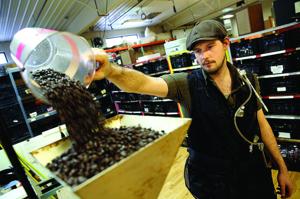Coffee roasters' health at risk from chemical compound

Mike De Sisti/Milwaukee Journal
Just Coffee Cooperative’s Benjamin Lisser prepares to grind coffee. The glass tube on his vest tests the air in his breathing zone for two chemicals known to destroy lung capacity.
THE TESTING RESULTS EXPOSE POTENTIAL PROBLEMS IN PRODUCTION AREAS OF COMMERCIAL SETTINGS AND ARE NOT RELEVANT TO GRINDING AND BREWING COFFEE AT HOME OR SIPPING A CUP IN A CAFÉ.
Posted: Sunday, August 2, 2015 12:00 am
BY RAQUEL RUTLEDGE/MILWAUKEE JOURNAL SENTINEL
MILWAUKEE—Tucked inside a burlap sack at room temperature, green coffee beans pose no known danger.
Funnel a 90-pound batch into a 430-degree roaster and things change. A chemical reaction between the beans’ sugars and amino acids creates a toxic compound capable of crippling the lungs of anyone nearby.
But few, if any, commercial coffee roasters know it.
They stand close, smelling the beans periodically during the 14 minutes it takes to turn them into a ready-to-be-ground roast. As the beans spill from the roasting drums into the cooling rack, roasters again inhale the fumes—the aromas made delicious, in part, by the same molecular formula tied to hundreds of injuries and at least five deaths.
Most coffee roasters have never heard of the chemical compound diacetyl. Those who have, associate it solely with its devastating effects on microwave popcorn workers and those in the flavoring industry. They don’t suspect that it could be wreaking the same havoc on their own lungs.
We don’t make flavored coffee, many in the roasting business say. It’s not a problem for us. But air sampling by the Milwaukee Journal Sentinel shows reason to worry.
Tests at two midsize Wisconsin roasteries that agreed to let the news organization analyze the air in their production areas found diacetyl levels from unflavored roasted coffee that exceeded safety standards proposed by the U.S. Centers for Disease Control and Prevention—in some areas, by nearly four times the concentration.
Workers exposed to similar levels at popcorn plants suffered serious, incurable lung disease.
“If roasters our size knew what this was, they would be super proactive,” said Matt Earley, co-founder of Madison-based Just Coffee Cooperative, one of the two roasting operations that allowed the air sampling. “There needs to be hyper-awareness among people roasting and grinding coffee.”
Valentine Coffee on Milwaukee’s west side also agreed to air sampling by the Journal Sentinel.
Four other roasting companies around southeastern Wisconsin—Anodyne, Colectivo, Stone Creek and Sheboygan-based Torke— declined to allow the Journal Sentinel to sample the air around their workers.
The Journal Sentinel’s diacetyl testing follows the discovery of five workers in a commercial coffee roasting plant in Tyler, Texas, who contracted debilitating lung diseases linked to the chemical.
The workers—one of whom was put on the waiting list for a lung transplant— believed their illnesses were caused by diacetyl in the liquid they added to the beans at Distant Lands Coffee to make hazelnut-flavored coffee. The coffee workers filed a lawsuit against the flavoring manufacturer in 2012 and settled it in October.
Nobody paid much attention at the time to levels of naturally occurring diacetyl wafting from the beans themselves. Not coffee roasters, business owners, regulators or labor unions.
Although the roasting of coffee beans has been known for years in scientific circles to emit diacetyl, few studies exist measuring the concentrations and exposure levels for coffee workers.
Such information is critical, scientists say, because naturally occurring diacetyl is identical in structure to the synthetic version found in flavorings and causes the same damage to the respiratory system. The human body cannot differentiate between the two.
Diacetyl, hailed for its buttery flavor, has been deemed by the U.S. Food and Drug Administration as safe to ingest in small amounts, although more than a dozen studies have shown it can be toxic when inhaled.
“It’s prudent to be concerned,” said Kay Kreiss, a scientist with the National Institute of Occupational, Safety and Health, the research arm of the CDC, and one of the country’s leading experts on diacetyl in the workplace.
“This merits attention because of the seriousness of the irreversible lung disease.”
It’s unclear how many coffee workers might be affected, as neither the government nor industry groups keep track. The U.S. Bureau of Labor Statistics lists 658 establishments nationwide that manufacture coffee or tea as a primary business. Those companies employ nearly 20,000 people.
The figures don’t list job titles and they don’t include smaller roasteries that operate in cafés. Nearly 600,000 workers are employed by businesses that fall into that category, listed as “snack and nonalcoholic beverage bars.”
Roast masters at Just Coffee and Valentine Coffee said they were not aware their jobs posed any danger to their lungs. Both businesses operate out of spacious and clean facilities with industrial exhaust systems on roasting equipment. No haze or pungent smells linger. Nothing indicates a threat.
The testing results expose potential problems in production areas of commercial settings and are not relevant to grinding and brewing coffee at home or sipping a cup in a café.